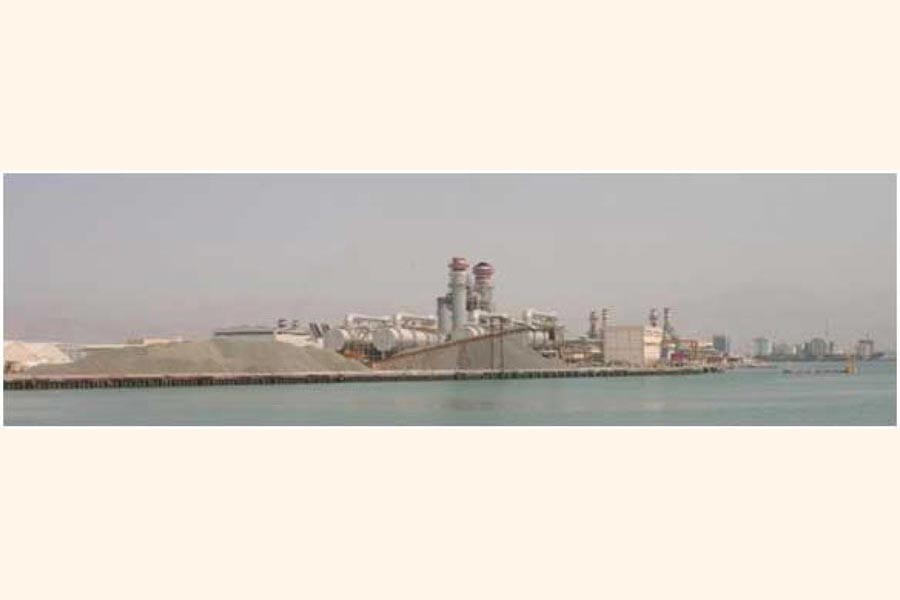Edward Jones, Manzoor Qadir and Vladimir Smakhtin in Hamilton, Canada | January 22, 2019 00:00:00
 Desalination plant, UAE
Desalination plant, UAE Starting from a few, mostly Middle Eastern facilities in the 1960s, today almost 16,000 desalination plants are in operation in 177 countries, producing 95 million cubic meters of freshwater every day - equal to about half the flow over Niagara Falls.
Falling economic costs of desalination and the development in membrane technologies, particularly reverse osmosis, have made desalination a cost-competitive and attractive source of freshwater around the globe.
The increase in desalination has been driven by intensifying water scarcity due to rising water demands associated with population growth, increased water consumption per capita, and economic growth, coupled with diminishing water supplies due to climate change and contamination.
Worldwide, roughly half a billion people experience water scarcity year round; for 1.5 to 2.0 billion people water resources are insufficient to meet demands for at least part of the year. Desalination technologies can provide an unlimited, climate independent and steady supply of high quality water, predominantly used by the municipal and industrial sectors.
In particular, desalination is an essential technology in the Middle East and for small island nations which typically lack renewable water resources. In coming decades, according to predictions, the number of desalination plants will increase to quench a growing thirst for freshwater in homes, industrial facilities, and on farms.
This fast-growing number of plants, however, creates a salty dilemma: how to deal with all the chemical-laden leftover brine?
We analysed a newly-updated dataset - the most complete ever compiled - to revise the world's badly outdated statistics on desalination plants. Most startling was our finding that the volume of hypersaline brine produced overall is about 50 per cent more than previously estimated. Globally, plants now discharge 142 million cubic meters of hypersaline brine every day - enough in a single year (51.8 billion cubic meters) to cover Florida under 1.0 foot (30.5 cm) of brine.
Considered another way, the data shows that for every unit of freshwater output, desalination plants produce on average 1.5 units of brine (though values vary dramatically, depending on the feedwater salinity, the desalination technology used, and local conditions).
Some two-thirds of desalination plants are in high-income countries, with capacity concentrated in the Middle East and North Africa. And over half - 55 per cent - of global brine is produced in just four countries: Saudi Arabia (22 per cent), UAE (20.2 per cent), Kuwait (6.6 per cent) and Qatar (5.8 per cent).
Middle Eastern plants, which largely operate using seawater and thermal desalination technologies, typically produce four times as much brine per cubic meter of clean water as plants where river water membrane processes dominate, such as in the US.
Brine disposal methods, meanwhile, are largely dictated by geography but traditionally include direct discharge into oceans, surface water or sewers, deep well injection and brine evaporation ponds.
Desalination plants near the ocean (almost 80 per cent of brine is produced within 10km of a coastline) most often discharge untreated waste brine directly back into the marine environment.
Brine raises the salinity of the receiving seawater, and brine underflows deplete dissolved oxygen needed to sustain life in the marine environment. This high salinity and reduced levels of dissolved oxygen can have profound impacts on marine ecosystems and organisms, especially those living on the seafloor, which can translate into ecological effects observable throughout the food chain.
Furthermore, the oceans are polluted with toxic chemicals used as anti-scalants and anti-foulants in the desalination process (copper and chlorine are of major concern).
There is a clear need for improved brine management strategies to meet this rising challenge. This is particularly important in countries producing large volumes of brine with relatively low efficiencies, such as Saudi Arabia, UAE, Kuwait and Qatar.
In fact, we can convert this environmental problem into an economic opportunity. Brine has many potential uses, offering commercial, social and environmental gains.
It has been used for aquaculture, with increases in fish biomass of 300 per cent achieved. It has also been successfully used to irrigate salt tolerant species, to cultivate the dietary supplement Spirulina, to generate electricity, and to irrigate forage shrubs and crops (although this latter use can cause progressive land salinisation).
With improved technologies, a large number of metals, salt and other minerals in desalination plant effluent could be mined.
These include sodium, magnesium, calcium, potassium, bromine, boron, strontium, lithium, rubidium and uranium, all used by industry, in products, and in agriculture.
The needed technologies are immature, however; recovery of these resources is economically uncompetitive today.
UN University Institute for Water, Environment and Health (UNU-INWEH) is actively pursuing research and ideas related to a variety of unconventional water sources, all of which need to be scaled up urgently to meet the even greater deficit in freshwater supplies looming in much of the world.
In particular, we need to make desalination technologies more affordable and extend them to low-income and lower-middle income countries.
Thankfully, costs are falling from continued improvements in membrane technologies, energy recovery systems, and the coupling of desalination plants with renewable energy sources.
At the same time, we have to address potentially severe downsides of desalination - the harm of brine and chemical pollution to the marine environment and human health.
The good news is that efforts have been made in recent years and, with continuing technology refinement and improving economic affordability, we see a positive and promising outlook.
Vladimir Smakhtin is Director, and Manzoor Qadir is Assistant Director, of the UN University Institute for Water, Environment and Health (UNU-INWEH) in Canada, hosted by the Government of Canada and McMaster University. Edward Jones, who worked on the paper at UNU-INWEH, is now a researcher at Wageningen University, The Netherlands.
—Inter Press Servic
© 2025 - All Rights with The Financial Express
